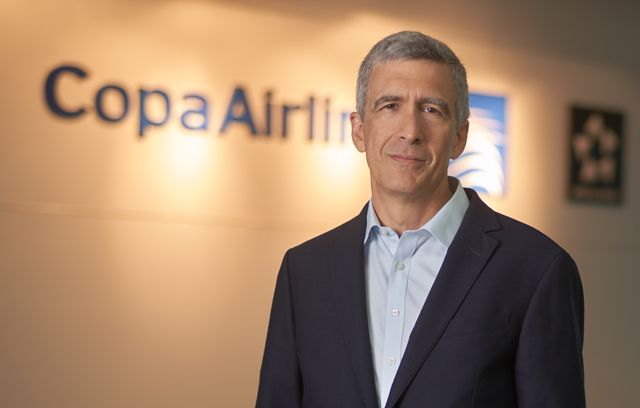Copa Airlines chief executive Pedro Heilbron is somewhat of an anomaly in the airline sector. While other airline leaders have come and gone through industry consolidation, geopolitical challenges and global economic downturns, Heilbron has remained at the helm of Copa for 30 years, steering what is arguably the most consistently profitable airline in Latin America today.
That sort of reliability is a crucial pillar in Copa's ethos, or as Heilbron states plainly: "We are very pragmatic about everything we do." Even as other carriers have expanded to other geographies and diversified their fleets, Copa has steadfastly clung to a tried-and-tested business model of serving the Americas with narrowbodies, with its Panama City Tocumen hub at the centre of this strategy.

The Monkey Studios
This clear-eyed focus plays a key role in Copa's financial performance. Even though it is only the fifth-largest airline in Latin America in terms of revenue and traffic, Copa's net profit of $370 million in 2017 was the highest among its peers in the region. Its full-year operating profit of $440 million is second only to LATAM, the region's largest carrier.
Industry observers may be quick to point out that unlike other Latin American airlines, Copa's strength is in part due to its geographic location, nestled between North and South America as the perfect connecting point. Operating in the fully dollarised economy of Panama, Copa is less exposed to the dramatic currency-exchange fluctuations that often plague its peers. The Central American country is also regularly lauded as one of the few pro-aviation states in a region where airline chiefs have long complained about over-regulation and airport congestion.
Heilbron does not argue when this is pointed out. "Yes, we like that," he says with a laugh, referring to Copa's location and the support from Panama's government. However, he is quick to add that the airline's performance cannot be attributed alone to its nationality.
"We are consistently between the second and fourth most on-time airline in the world, and number one in Latin America, year-in year-out," he tells FlightGlobal in Copa's Panama City headquarters.
"We also have one of the lowest unit cost of any full-service airline worldwide, so that's another advantage. We are very cost- and efficiency-conscious in everything we do, and we've been this way forever, in good times and in bad times."
Over the past five years, Latin America has seen its fair share of bad times. A severe economic downturn in Brazil – the region's largest economy – depressed airline operating profits and forced many carriers to drastically slow growth.
Even though the macroeconomic conditions this year are a marked improvement from those days, Latin America is hardly sailing along. Demand weakness in Argentina and Brazil – mostly tied to currency weakness in both – has forced the region's airlines to reconsider capacity plans for the year.
Copa likewise took the prudent step of reducing full-year capacity growth by a point, and will now increase ASMs by 8% in 2018. Heilbron says that while Latin American economies in the past have strengthened with rising fuel prices, that has not happened recently.
"It's been very difficult to increase yields to compensate for the higher fuel," he says. "It's something that again forces us to be very careful with how we manage capacity the rest of the year."
COPA'S NEXT CHAPTER
With a network of over 70 destinations and a fleet of more than 100 aircraft, the Copa of today bears little resemblance to the small regional carrier with two Boeing 737s that Heilbron began leading in 1988. The 71-year-old airline will soon embark upon its next phase of growth, when a new terminal at Tocumen opens in 2019.
This facility, which will add 20 gates to the 34 currently at the airport, will play a key role in Copa's growth in the coming years. The airline currently uses a number of remote positions at Tocumen to meet demand, but foresees less need for them once the new terminal begins operations.
With the additional airport capacity, further efficiency gains are on the way for Copa, which has built its schedules around the premise of a fuss-free layover at Tocumen. The average layover on a Copa itinerary at the airport currently stands at 75min.
"It's more than 50% growth," says Heilbron of the additional gates. "That's going to give us an opportunity to leverage that new infrastructure to improve the passenger's experience of connecting through the hub of the Americas in Panama."
Operations from the new terminal could begin as early as later this year, with flights out of six to eight of the 20 new gates before a full inauguration in 2019, says Heilbron. Further down the road, another eight gates could be added to the terminal, although it is not yet known when this second phase would take place.
"We are waiting for the new terminal to be inaugurated before we start talking about more new gates," he says.

The Monkey Studios
In the longer term, a third runway at Tocumen has been envisaged. Heilbron expects planning to start in 2019 and construction to begin in 2020 for an operational date of 2023. A third runway would allow for fully parallel operations, and would meet the needs for more flights in the future. In the meantime, a planned redesign of the airspace around Tocumen will be completed in the next two to three years, says Heilbron.
"We are hoping to increase the number of hourly operations that Tocumen can handle," he says.
The arrival of the new terminal will dovetail with fleet efficiencies slated to come online at Copa. It took delivery of its first Boeing 737 Max 9 in late August, out of an order for 71 of the Max family.
The airline will deploy the aircraft on its longest routes from Panama City, with San Francisco the first destination to be served by the jets. "It's our longest [route] and the Max 9 will have the best performance," says Heilbron. "It will be able to carry full loads, which means more cargo, and we will get the full Max cost advantage by operating it on our longest routes."
San Francisco was also chosen because it is a hub of Copa's partner United Airlines, which already operates the 737 Max 9, in case the Panamanian airline requires support for its new aircraft type. Boeing's facilities in Washington state are also close by, Heilbron points out. "Those are two factors that will help the reliability of the aircraft, which is very important for Copa," he says.
Copa will add five 737 Max 9s this year, and another eight in 2019. Besides San Francisco, Copa will deploy the aircraft on its other longer-haul routes, such as Los Angeles, Buenos Aires, Sao Paulo, Santiago and Montevideo.
While the airline holds orders for three variants of the 737 Max – the Max 8, 9 and 10 – Copa is particularly fond of the Max 9, despite the fact that the variant is unlikely to open up new cities for Copa's network. "We like the combination of range performance and capacity. We think it's the perfect combination and we will not be surprised if in the future it becomes more popular than the Max 8," Heilbron says.
With the airline not receiving its first Max 8 until 2020, Heilbron says Copa could choose to convert its order for some Max 8s to Max 9s. In 2019, half of Copa's eight 737 Max 9 deliveries will be growth aircraft, while the remaining four will replace its older 737NGs.
The new aircraft will allow Copa to consolidate its new routes and boost frequencies to high-demand destinations that require more capacity. The airline will add five new destinations to its network this year: Fortaleza and Salvador in Brazil, Barbados, Salta in Argentina, and Puerto Vallarta in Mexico.
A couple more new destinations in 2019 are a possibility, although Heilbron cautions that this will depend on macroeconomic conditions and whether fuel prices continue to creep upwards. Capacity growth could be slowed further, he says. A flexible fleet plan allows Copa to step on the brakes when it sees the need to – as it did during the economic recession in Latin America, Heilbron says.
"We always keep a very, very flexible fleet plan with staggered lease returns and with slide rights with Boeing... We keep that flexibility to adjust capacity growth on short notice to better respond to market realities," he says. "If fuel stays up and currencies stay down, we might decide to grow less than what we are planning right now."
LOW-COST FORAY
With its prudent approach in managing growth and strict adherence to its business model, Copa is widely viewed as being very conservative – a perception that Heilbron himself acknowledges. So when the airline announced in October 2016 that it would launch Wingo, a new low-cost affiliate in Colombia, the industry sat up and took notice.
Wingo took over most of the network operated by Copa's loss-making Colombian subsidiary, with the exception of its service to and from Panama City Tocumen. Before the arrival of Wingo, Copa Colombia had struggled to earn a profit while offering a full-service product on its routes that predominantly served leisure passengers.
"The other international flights out of Bogota that have nothing to do with our Panama hub, which are mostly to leisure destinations, they are low-yielding markets," Heilbron told FlightGlobal in 2016 when Wingo was unveiled. "We are serving them with a full-service product with higher costs, free meals and free bags. It is really, really difficult to make that work."

The Monkey Studios
The roots of Bogota-based Wingo came out of ongoing planning conversations within Copa, at a time when foreign companies were beginning to eye Latin America as an opportunity for new low-cost carriers.
Copa knew that low-cost airlines operate in a way that was extremely different from its full-service model, but "that was not a strong enough reason not to pursue it if it made sense", even if it was in just a few of Copa's markets, says Heilbron.
"Why let outsiders develop a business model if we can do it ourselves? If LCCs are going to have success in Latin America, we wanted to be a player and share in that success, and not just allow others to develop the segment the way it's happened in Europe and in the US," he says.
Copa is pleased so far with Wingo's performance, and Heilbron says that it could perhaps break even this year. "Wingo is performing better than expected. It hasn't grown, and is still operating the same four aircraft... so it's kind of the same Wingo, but it's consolidating its position in the markets it serves."
The launch of Wingo has already contributed to Copa Colombia's financial performance. It reported an operating profit of Ps7.11 billion ($2.42 million) in 2017, according to statistics from Colombian civil aviation regulator Aerocivil, swinging from an operating loss of Ps49.4 billion in 2016.
With a splash of bright violet on the tails of four ex-Copa 737s, Wingo appears to be everything Copa is not. Browse Wingo's website, and you would be hard-pressed to find a mention of Copa anywhere. Copa does not interline or codeshare with Wingo, and does not sell the low-cost affiliate's flights.
But behind the scenes, Wingo has the full support of Copa's technical expertise – an arrangement that has helped Wingo earn the reputation for on-time performance and completion rate that Copa is known for.
"Although it's only a four-airplane fleet, they have the support of a 100-plus aircraft operation, and that's worked very well," says Heilbron.
While Wingo's launch came as a surprise to those familiar with Copa, Heilbron stresses that the low-cost affiliate remains an "opportunistic venture" for the overall company. "No matter what kind of product Wingo offers, it has to be solid and reliable. But beyond that we haven't set specific targets, like by such a year we need to have so many planes or so many routes or passengers. Wingo will fly where it makes sense and money."
The approach is in the same vein as the careful pragmatism that has driven Copa's success for so many years under Heilbron's leadership, as the airline resolutely sticks with the strategy that has served it well.
"It's what works best for us," he says. "It's better to get very strong in what we do, as long as you see growth opportunities, rather than spreading oneself too thin, like many others have done in the past."
Source: Airline Business






















